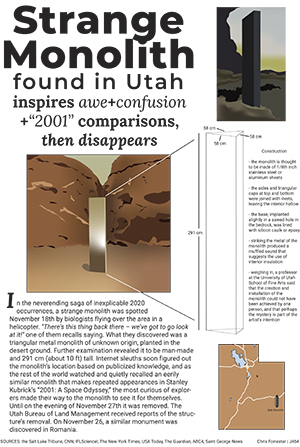For my third and final illustrator project this semester, I wanted to challenge myself to do something different than my previous work, which was largely focused on pandemic-related stories about what’s happening in the world of entertainment. That was in part because there isn’t an easy subject matter to conceive of there that makes for a compelling diagram (a map of theater distanced-seating regulations? yawn), so I set my sights on something I thought would be more visually interesting: the now-vanished Utah monolith.
Admittedly, it’s lacking as a piece of subject matter in one key way for this project, which is that it’s not especially complicated to illustrate and its construction is fairly simple: three sides, a base, a top. The rest is all interior (and has never been/will never be seen) and/or speculated. To compensate for that I wanted to include more playful illustrations so that my diagram would still give me a chance to flex my illustrator muscles. The main illustration was the obvious choice, although I wish that I had actually left the monolith in the illustration there as a white skeleton like the one on the right, and then had the actual “diagram” be in color to add a more dynamic element to the main graphic. I also think that the white skeleton of the monolith looks a bit bland where it’s placed, and produces a weird chessboard effect where there’s color in the top right, middle left, and bottom right of the diagram. In hindsight I also think that I could have been more creative with the 2001 reference; if I were to go back and do this again, I would choose an even fatter slab font for “Strange Monolith Found in Utah” and stretched that text across all three columns, then converted it to outlines and used it as a clipping mask for a wider illustration of the monolith – that’s more fun! It’s less obvious in construction but also makes better and more interesting use of space, and doesn’t distract so much from the design of the news-worthy parts of the diagram so much.
I also added a map because it seemed to me that if the monolith itself is so mysterious in construction, then one of the more important things that *is* known about it is where it once stood.


